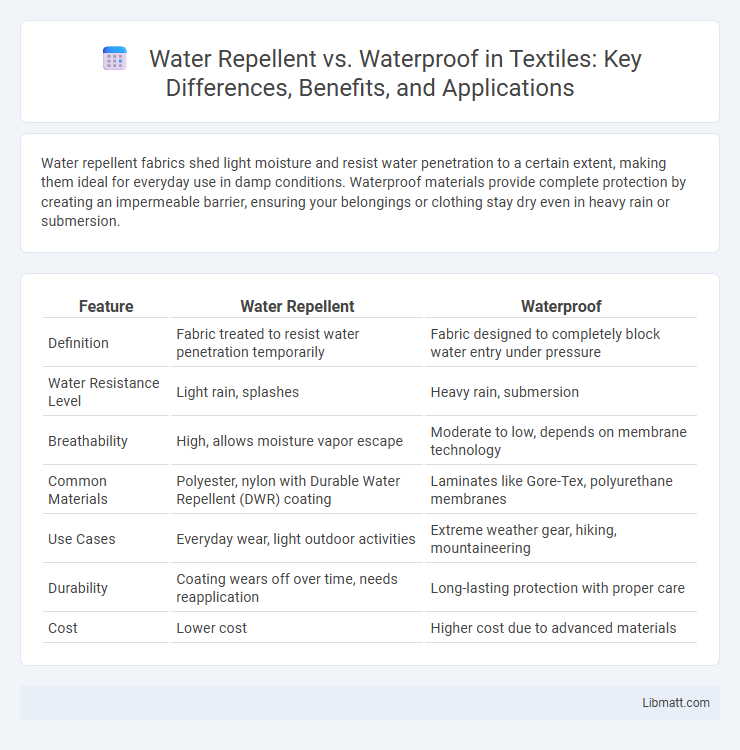Water repellent fabrics shed light moisture and resist water penetration to a certain extent, making them ideal for everyday use in damp conditions. Waterproof materials provide complete protection by creating an impermeable barrier, ensuring your belongings or clothing stay dry even in heavy rain or submersion.
Table of Comparison
| Feature | Water Repellent | Waterproof |
|---|---|---|
| Definition | Fabric treated to resist water penetration temporarily | Fabric designed to completely block water entry under pressure |
| Water Resistance Level | Light rain, splashes | Heavy rain, submersion |
| Breathability | High, allows moisture vapor escape | Moderate to low, depends on membrane technology |
| Common Materials | Polyester, nylon with Durable Water Repellent (DWR) coating | Laminates like Gore-Tex, polyurethane membranes |
| Use Cases | Everyday wear, light outdoor activities | Extreme weather gear, hiking, mountaineering |
| Durability | Coating wears off over time, needs reapplication | Long-lasting protection with proper care |
| Cost | Lower cost | Higher cost due to advanced materials |
Introduction to Water Repellent vs Waterproof
Water repellent fabrics resist water penetration by causing liquid to bead and roll off the surface, offering lightweight protection against light rain and splashes. Waterproof materials provide a complete barrier, ensuring no water passes through even under heavy or prolonged exposure, making them ideal for extreme weather conditions. Your choice between water repellent vs waterproof depends on the level of moisture protection required for your activities.
Understanding Water Repellent: Definition and Features
Water repellent fabrics are treated with a durable water-resistant (DWR) coating that causes water to bead and roll off the surface, preventing light moisture absorption. Unlike waterproof materials, water repellent fabrics allow breathability and are ideal for light rain or damp conditions. Your choice between water repellent and waterproof depends on the level of protection and comfort you need in wet environments.
What Does Waterproof Really Mean?
Waterproof means a product completely prevents water from penetrating under any conditions, ensuring your belongings stay dry even when submerged or exposed to heavy rain. It uses materials and construction methods, such as sealed seams and impermeable coatings, to block all water entry. You should choose waterproof gear when you need reliable protection in extreme wet environments or prolonged exposure to water.
Key Differences: Water Repellent vs Waterproof
Water repellent fabrics resist water penetration by causing liquid to bead up and roll off the surface, but they are not fully impermeable under prolonged exposure. Waterproof materials provide a complete barrier against water, featuring sealed seams and membranes that prevent any moisture from passing through, even in heavy rain or submersion. The key difference lies in the level of protection and durability, with waterproof items offering superior resistance suitable for extreme weather conditions compared to the lighter, short-term resistance of water repellent options.
Materials Commonly Used for Water Repellent Products
Water repellent products frequently utilize materials such as polyester, nylon, and treated cotton fabrics enhanced with Durable Water Repellent (DWR) coatings to resist water penetration. These coatings create a hydrophobic surface that causes water to bead and roll off without fully sealing the fabric, maintaining breathability and comfort. Your choice between water repellent and waterproof materials should consider the expected exposure, as water repellent fabrics offer protection against light rain, whereas waterproof options provide complete water impermeability.
Technologies Behind Waterproof Materials
Waterproof materials utilize advanced technologies like hydrophobic coatings, polyurethane laminates, and laminated membranes such as Gore-Tex to create barriers that completely prevent water penetration. Nanotechnology enables the development of microscopic surface textures that repel water molecules, enhancing fabric performance without compromising breathability. Your choice between water repellent and waterproof options should consider these technologies to ensure optimal protection based on specific environmental conditions.
Pros and Cons: Water Repellent vs Waterproof
Water repellent fabrics offer lightweight breathability and quick-drying properties, making them ideal for mild rain but may allow water penetration under heavy exposure. Waterproof materials provide complete protection against water ingress, ensuring dryness in extreme weather, but often sacrifice breathability and can feel heavier. You should consider your activity level and weather conditions to choose between the comfort of water repellency and the absolute protection of waterproof gear.
How to Choose Between Water Repellent and Waterproof
Choosing between water repellent and waterproof fabrics depends on the level of water protection needed and the intended activity. Water repellent materials resist light rain and splashes by causing water to bead off the surface, ideal for casual use or dry conditions. Waterproof fabrics, often featuring sealed seams and membranes like Gore-Tex, provide complete protection against heavy rain and prolonged exposure, making them suitable for outdoor activities in harsh weather.
Care and Maintenance Tips for Both Types
Water repellent fabrics require gentle cleaning with mild detergents to preserve their durable water-repellent (DWR) coating, avoiding fabric softeners that can reduce water resistance. Waterproof materials benefit from regular washing and reapplication of waterproofing sprays or washes to maintain their impermeable membrane's effectiveness and breathability. Proper drying methods, such as air drying or low heat in a dryer, help extend the life of both water repellent and waterproof garments by protecting fabric integrity and performance.
Frequently Asked Questions on Water Repellent and Waterproof
Water repellent fabrics resist moisture by causing water to bead and roll off the surface, while waterproof materials provide a complete barrier that prevents water penetration under pressure. Common questions often address durability, breathability, and ideal use cases for each, with water repellent items preferred for light rain and waterproof gear necessary for heavy rain or prolonged exposure. Consumers also ask about maintenance, such as reapplying treatments for water repellent fabrics and the impact of waterproof coatings on comfort and fabric flexibility.
Water Repellent vs Waterproof Infographic

 libmatt.com
libmatt.com